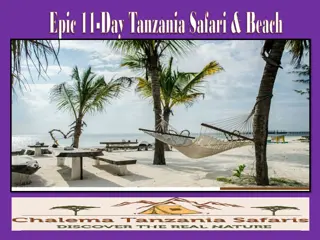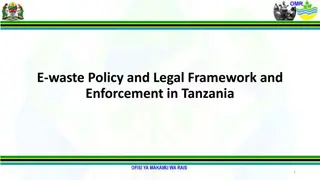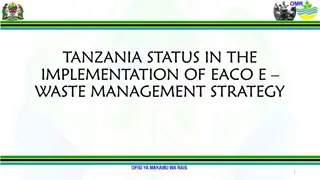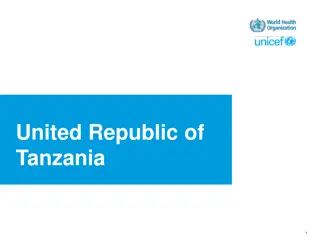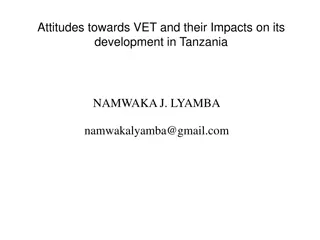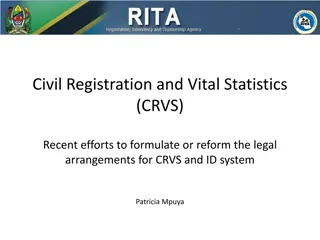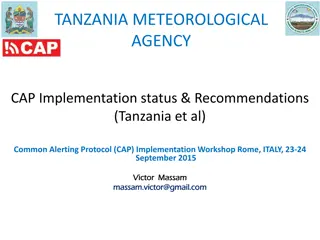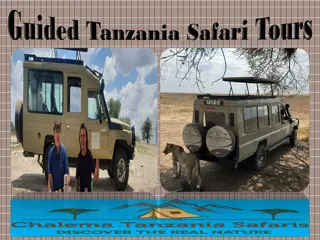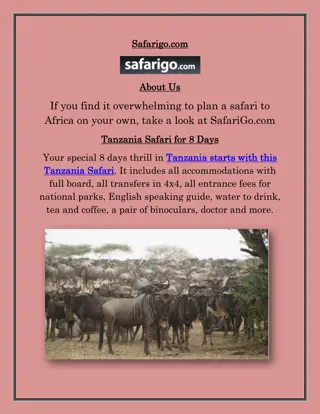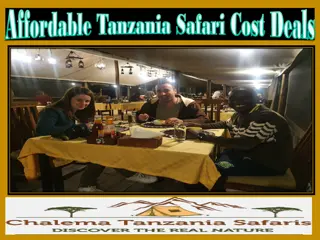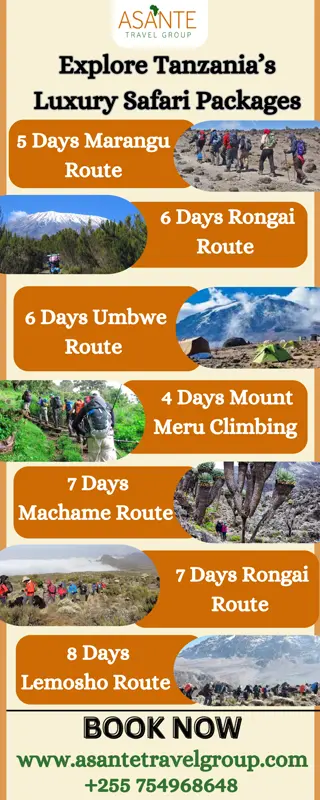
Export Corridors and Investment Climate for Value Chain Development in Tanzania
Explore the competitiveness and diversification along key export corridors in Tanzania, focusing on the investment climate for value chain development. Discover the initiatives, challenges, and opportunities for enhancing trade and investment in the region.
Download Presentation

Please find below an Image/Link to download the presentation.
The content on the website is provided AS IS for your information and personal use only. It may not be sold, licensed, or shared on other websites without obtaining consent from the author. If you encounter any issues during the download, it is possible that the publisher has removed the file from their server.
You are allowed to download the files provided on this website for personal or commercial use, subject to the condition that they are used lawfully. All files are the property of their respective owners.
The content on the website is provided AS IS for your information and personal use only. It may not be sold, licensed, or shared on other websites without obtaining consent from the author.
E N D
Presentation Transcript
Competitiveness and Diversification Along Key Export Corridors and Investment Climate for Value Chain Development Donald Mmari KNOWLEDGE SHARING ON TRADE AND INVESTMENT GOOD PRACTICES , ACP House, Brussels, Belgium 21stFebruary 2018 1
Outline Introduction Policy Landscape Outputs of Programme of Support Good Practice Cases Key constraints to competitiveness Limits of TA Support Way Forward 2
Introduction Tanzania is an emerging economy experiencing long term growth rates of over 6% per annum since 2005. Tanzania is an attractive trade and investment destination by virtue of: political stability, advantageous geographical location with a 1,424 km long coastline and 8 neighbours, youthful and growing population, est. 51.5 million in 2017, membership to regional trading blocks, EAC and SADC. AGOA, EPA Main export corridors: Southern, Western, Central, Northern and Zanzibar-Pemba 3
Introduction-2 Non-traditional exports growing, includes horticultural Traditional exports stagnant, except cashew and tobacco 4
Introduction-3 Trade Exports grew from 750 million in 2010 to 1,958 million in 2016. Imports grew from 4,032 million in 2010 to 6,155 million in 2016. Yet to ratify a regional Economic Partnership Agreement (EPA) with the EU Competitiveness Ranks poorly in the bottom quintile of WEF s Global Competitiveness Index at 116th out of 138 countries Ranks 139thout of 189 economies in World Bank s 2016 Doing Business report. Investment Net FDI flows have slowed to 2.9% of GDP ( 1,102 million) in 2016 from 5.8% ( 1,464 million) in 2010 (World Bank, 2017). 5
Outputs of Programme of support Current Programme: P006: Targeted Support to REPOA and Zanzibar Ministry of Trade, Industry and Marketing to Increase the Competitiveness of Primary Producers and Diversify the Export Base in light of the Trading Opportunities with the EU TA has two main purposes: Purpose 1: To identify bottlenecks that limits competitiveness and export diversification in agriculture and the trade policy framework to effectively address them; Purpose 2:To strengthen REPOA s and subsequently Tanzania s research and advisory capacity on trade policy, competitiveness and elimination of NTBs to enhance country s trading capacity with the EU and beyond. 7
Policy Landscape Current trade (2003 for Mainland, 2006 for Zanzibar) and investment policies (1996 for Mainland, 2004 for Zanzibar) are outdated to effectively promote competitiveness and diversification-quality matters, innovation is rapid, customization BUTpolicy revision underway: see WB s 2017 DTIS and Zanzibar s draft (but binned) 2016 policy. DTIS focuses on: agriculture, mining and extractives and tourism Trade and investment priorities are outlined in FYDP II with industrialization as its main agenda FYDP II supports value-addition and beneficiation towards improving agricultural productivity and deepening agricultural value chain 8
Good Practice Cases Zanzibar Exotic Originals Label Launched in 2015 involving the International Trade Centre (ITC), World Intellectual Property Organization (WIPO) and Zanzibar s State Trading Corporation (ZSTC) A sectoral brand strategy for spices Features premium branded packaging and promotional materials-islands history, spice story, tourism experience and investment potential Branded spices in tourist market- cloves, chilies, cinnamon and other organic spices Three-year pilot agreement in 2017 with GANEFRYD of Denmark, to export branded organic cloves and selected spices to Europe. 9
Good Practice Cases-2 AFRICADO COMPANY LTD State-of-the-art processing, cold-chain and packaging facility in 2012 - grant from TradeMark East Africa Challenge Fund (TRAC) Raised competitiveness of AFRICADO s products, improve quality of produce and access to the export market Avocado exports from 488,492 kgs (122,123 4kg cartons) in 2012 to 2,579,976 kgs (644,994 4kg cartons) in 2016, a 428.48% increase The first Tanzanian company exporting avocados to the UK-Ocado, Sainsbury, Tesco and Waitrose supermarkets 10
Lessons from the two cases Targeted support towards branding pays off, & farmers get more for their produce Investment in meeting quality standards, while expensive, helps to secure markets and stimulate export Sector specific policy reforms and PPP important Sustained efforts to enhance business environment and political stability attracts export oriented FDI Technology driven agriculture transformation is the way for the future but entry costs for small producers entails strategic value chain partnership 11
Limits of TA Support Short-termism: TA has not facilitated continued dialogue among Trade Support Institutions (TSIs) necessary for sustainable solutions to competitiveness and diversification bottlenecks. Lack of guidance in accessing implementation funds: TA s recommendations require substantial investment in TSIs and other value chain actors NOT financially supported by TA. Medium to long-term sustainability of TA at risk as not much learning has occurred between TSIs and other value chain actors. TA prioritised research capacities of beneficiaries while eschewing knowledge and skill transfer to producers and processors 13
Way Forward Additional support to REPOA and other TSIs to play a prominent role in revision of Tanzania s trade policy to foster the competitiveness of agro-exports, diversification and value chain development. This would improve policy impact of TA Further TA needed to institute a long-term research programme on trade policy and regional integration, building on present TA to address long-standing concerns on agri-trade research data inconsistencies, M&E systems Sustainable capacity building needed to build a critical mass of policy analysts, researchers and trade negotiators in Tanzania 14


